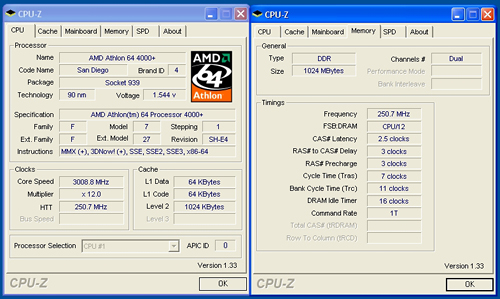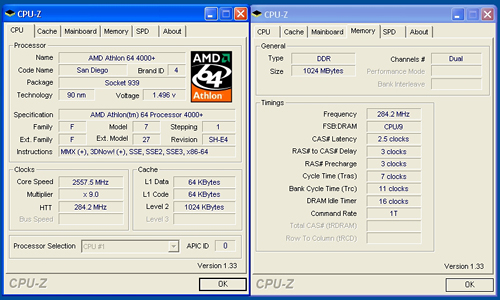FSB Overclocking Results


Our 4000+ CPU posted very good results in the stock multiplier overclocking test. We were able to reach a very stable overclock of 251HTT x12. We were also able to boot Windows with a 256HTT x12 setting but could not complete our entire test suite.
Unfortunately, our maximum HTT speed attained was 284HTT x9. The board could POST at 292HTT x9 but was not stable. We were unable to POST at 300HTT or higher, though this processor has completed testing at a 330HTT x9 setting in the past.
We have contacted MSI engineering at this time and hopefully our results are due to a below average board as end users and other websites have exceeded the 300HTT level with the 3.0a BIOS. 284HTT isn't terrible, particularly when using higher CPU multipliers, but neither is it exceptional. Also, voltage levels remained consistent throughout testing. We did not notice any abnormal or out of range voltage fluctuations with this board.


Our Opteron 170 posted excellent results at the stock CPU multiplier settings but was hampered once again at the lower multiplier setting. At these overclocked settings the system was able to complete all of our benchmark test suites three consecutive times and run Prime95 for a minimum of four hours without issue. Overall the board would make an excellent platform for overclocking if the maximum HTT settings are improved.
Memory Stress Testing
Memory stress tests look at the ability of the MSI K8N Diamond Plus to operate at the officially supported memory frequencies of DDR-400 at the best performing memory timings the OCZ PC4800 Platinum Edition will support.
The MSI K8N Diamond Plus was superbly stable with 2 DDR modules in Dual-Channel mode at the settings of 2-2-2-5 at 2.7v. We were able to operate the memory at this configuration up to a 227HTT x12 setting. We will now install all four available memory slots that results in more strenuous requirement on the memory subsystem than testing 2 DDR modules on a motherboard.
The MSI K8N Diamond Plus was extremely stable with 4 DDR modules in Dual-Channel operation at the settings of 2-2-2-8 but required the command rate be increased to 2T along with a voltage increase to 2.75. We tested memory modules from several different suppliers with the same results.
| Front Side Bus Overclocking Testbed | |
| Processor | AMD Athlon 64 4000+ (San Diego) AMD Opteron 170 (Denmark) |
| CPU Voltage AMD Athlon 64 4000+ AMD Opteron 170 |
1.550V (1.400V default) 1.550V (1.350V default) |
| Memory Settings | 2.5-3-3-7 1T - (12x) 2.5-3-3-7 1T - (10x) 2.5-3-3-7 1T - (9x) |
| Memory Voltage | 2.8V |
| HT Multiplier | 4x - 250HTT ~ 285HTT |
| Memory | OCZ PC4800 Platinum Edition |
| Cooling | Tuniq Tower 120 |
| Power Supply | PC Power and Cooling 850 SSI |
| Maximum CPU Overclock AMD Athlon 64 4000+ |
251HTT x 12 (3008MHz) +25% |
| Maximum HTT Overclock AMD Athlon 64 4000+ |
284HTT x 9 (2557MHz) +42% |
| Maximum CPU Overclock AMD Opteron 170 |
284HTT x 10 (2841MHz) +42% |
| Maximum HTT Overclock AMD Opteron 170 |
282HTT x 9 (2543MHz) +41% |


Our 4000+ CPU posted very good results in the stock multiplier overclocking test. We were able to reach a very stable overclock of 251HTT x12. We were also able to boot Windows with a 256HTT x12 setting but could not complete our entire test suite.
Unfortunately, our maximum HTT speed attained was 284HTT x9. The board could POST at 292HTT x9 but was not stable. We were unable to POST at 300HTT or higher, though this processor has completed testing at a 330HTT x9 setting in the past.
We have contacted MSI engineering at this time and hopefully our results are due to a below average board as end users and other websites have exceeded the 300HTT level with the 3.0a BIOS. 284HTT isn't terrible, particularly when using higher CPU multipliers, but neither is it exceptional. Also, voltage levels remained consistent throughout testing. We did not notice any abnormal or out of range voltage fluctuations with this board.


Our Opteron 170 posted excellent results at the stock CPU multiplier settings but was hampered once again at the lower multiplier setting. At these overclocked settings the system was able to complete all of our benchmark test suites three consecutive times and run Prime95 for a minimum of four hours without issue. Overall the board would make an excellent platform for overclocking if the maximum HTT settings are improved.
Memory Stress Testing
Memory stress tests look at the ability of the MSI K8N Diamond Plus to operate at the officially supported memory frequencies of DDR-400 at the best performing memory timings the OCZ PC4800 Platinum Edition will support.
| MSI K8N Diamond Plus Stable DDR-400 Timings - 2 DIMMs (2/4 slots populated - 1 Dual-Channel Bank) |
|
| Clock Speed | 200MHz |
| CAS Latency | 2 |
| RAS to CAS Delay | 2 |
| RAS Precharge | 2 |
| RAS Cycle Time | 5 |
| Command Rate | 1T |
| Voltage | 2.7V |
The MSI K8N Diamond Plus was superbly stable with 2 DDR modules in Dual-Channel mode at the settings of 2-2-2-5 at 2.7v. We were able to operate the memory at this configuration up to a 227HTT x12 setting. We will now install all four available memory slots that results in more strenuous requirement on the memory subsystem than testing 2 DDR modules on a motherboard.
| K8N Diamond Plus Stable DDR-400 Timings - 4 DIMMs (4/4 slots populated - 2 Dual-Channel Banks) |
|
| Clock Speed | 200MHz |
| CAS Latency | 2 |
| RAS to CAS Delay | 2 |
| RAS Precharge | 2 |
| RAS Cycle Time | 8 |
| Command Rate | 2T |
| Voltage | 2.75V |
The MSI K8N Diamond Plus was extremely stable with 4 DDR modules in Dual-Channel operation at the settings of 2-2-2-8 but required the command rate be increased to 2T along with a voltage increase to 2.75. We tested memory modules from several different suppliers with the same results.










42 Comments
View All Comments
LoneWolf15 - Tuesday, April 11, 2006 - link
There are TV tuner cards based on ATI's Theater 550 chip, Powercolor makes one, details can be found here:http://www.powercolor.com/product_series_Theater.h...">http://www.powercolor.com/product_series_Theater.h...
Gary Key - Tuesday, April 11, 2006 - link
We are currently reviewing the Powercolor T55E-P03 for an upcoming HTPC article. I think the results against the PCI cards will be interesting. ;-)LoneWolf15 - Wednesday, April 12, 2006 - link
From what I've heard, there's little or no difference in performance. However, the Powercolor would be the card I'd consider for future-proofness.My only disappointment is it doesn't use ATI's Remote Wonder line of remote controls; they include an iR remote of their own choosing instead of the ATI RF model, IIRC.
nullpointerus - Tuesday, April 11, 2006 - link
Interesting, how? Better, worse, wierd, or just unspecified in a frustratingly vague kind of way? ;-)Gary Key - Wednesday, April 12, 2006 - link
Actual throughput was different than the PCI based card, not trying to be vague but I think the article we are putting together will explain it best, new benchmarks, software versus hardware, TV Tuners- single, dual, SD, and HD, single core CPU , dual core CPU, AMD, Intel, NVIDIA, ATI, MCE2005, Linux, PCI, PCI-E, USB, you know just the basics. ;-)
nullpointerus - Wednesday, April 12, 2006 - link
Cool, thanks. I'm looking forward to reading it.ceefka - Tuesday, April 11, 2006 - link
I don't quite get this one. I can imagine it would say something like 1394b can be had on a s939 Gigabyte board for less than $ 100,00 e.g. GA-K8NF9 Ultra. It seems Gigabyte is the only one with 1394b for s939.
Fact is though that there are few F800 devices out there. If you do have one of these, your mobo options are limited.
JarredWalton - Tuesday, April 11, 2006 - link
It should have been "can't be very large" of course. I'm a bit befuddled on how that slipped in there, because I know I corrected that once before. Must have accidentally pasted over the original text at some point.... Ah, well - fixed now regardless.Myrandex - Tuesday, April 11, 2006 - link
I agree too, there is no reason for manufacturer's to not include this. Firewire B devices will not be mass produced without the users with Firewire B ports. I have a Giga-byte s939 SLI mobo with Firewire B on there and I do want to purchase an external enclosure that supports the standard (along with A and USB), but I also wish we would get some highly OCable boards from the likes of Asus or Abit etc. that provides this feature for the future. And also I believe the article is wrong about the price difference being very large, or else you wouldn't see Giga-byte squeezing these into ~$100 boards with other manufacturer's at the same price point including only A (or no firewire at all).Jason
Duplex - Friday, April 14, 2006 - link
1394B to the people!!! Couldn't agree more!--
I also must give credit to MSI for including a parallel and serial port.
There aren't that many people with a printerserver or USB-printer at home (I think).